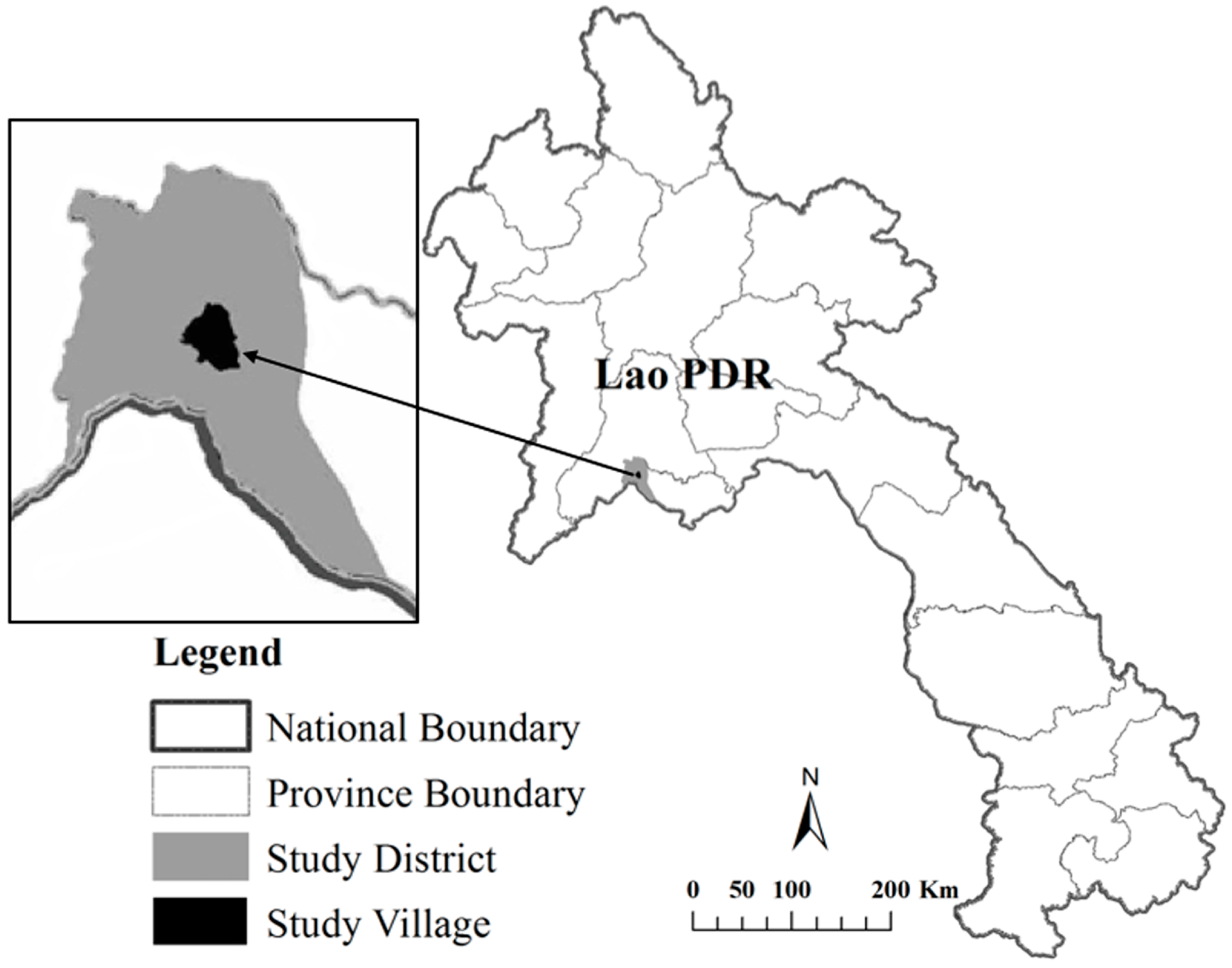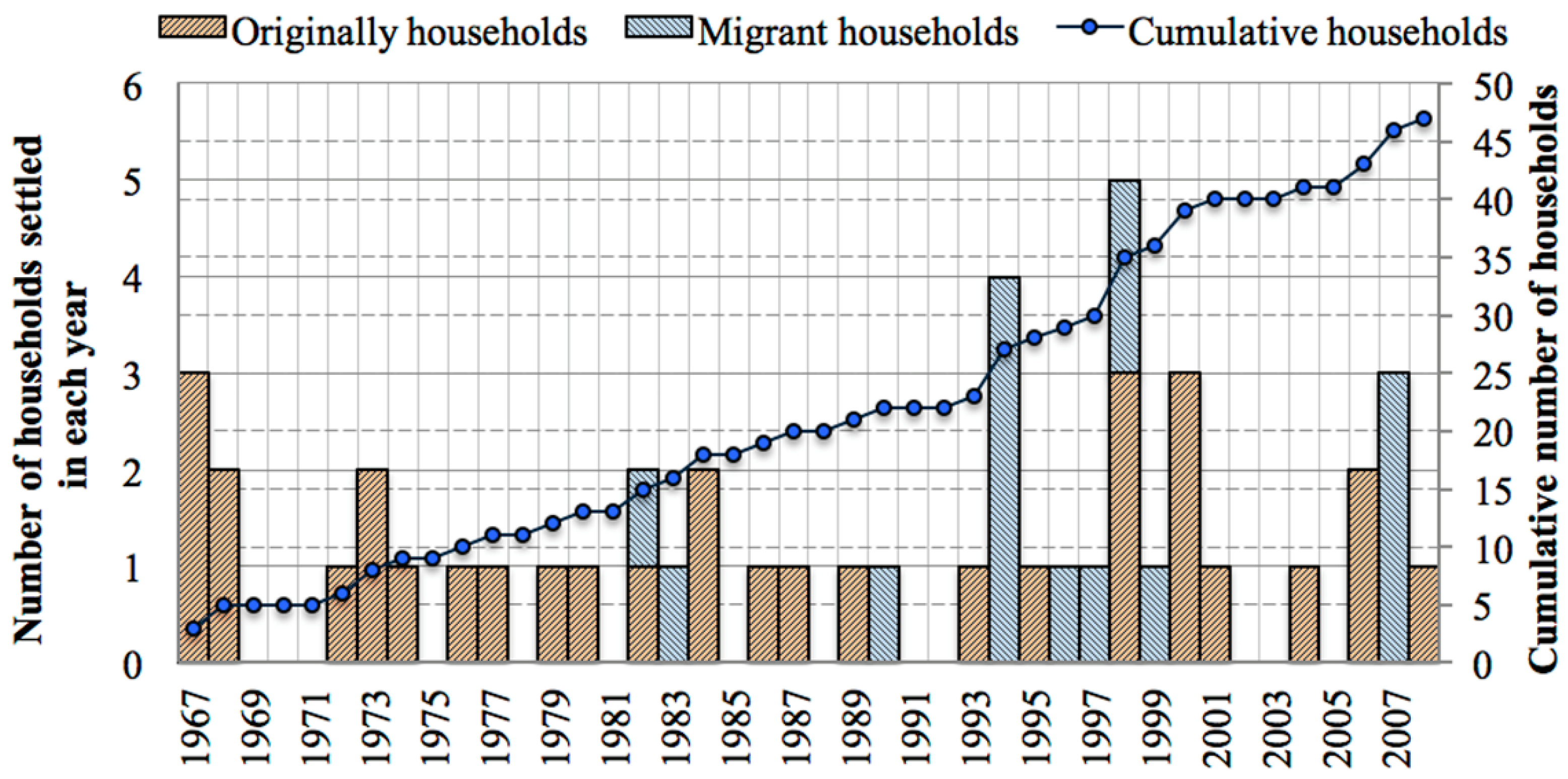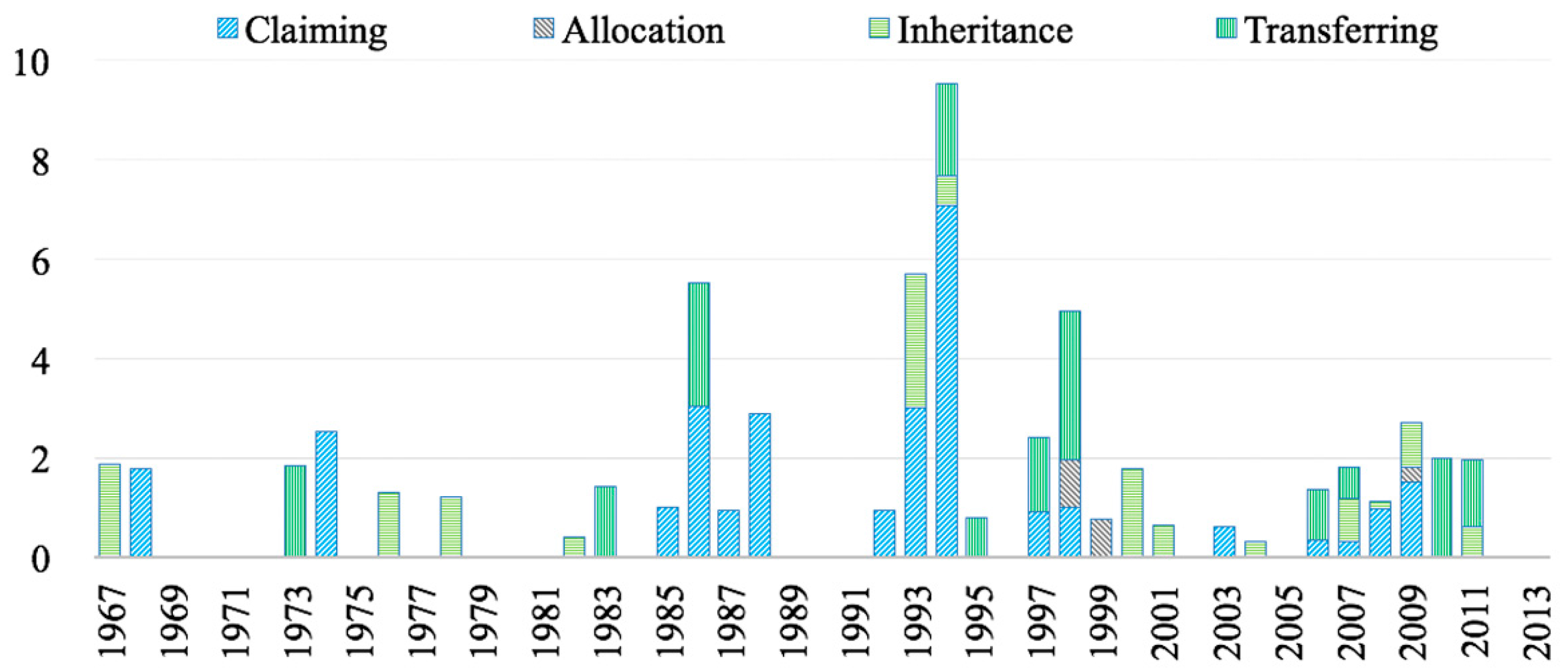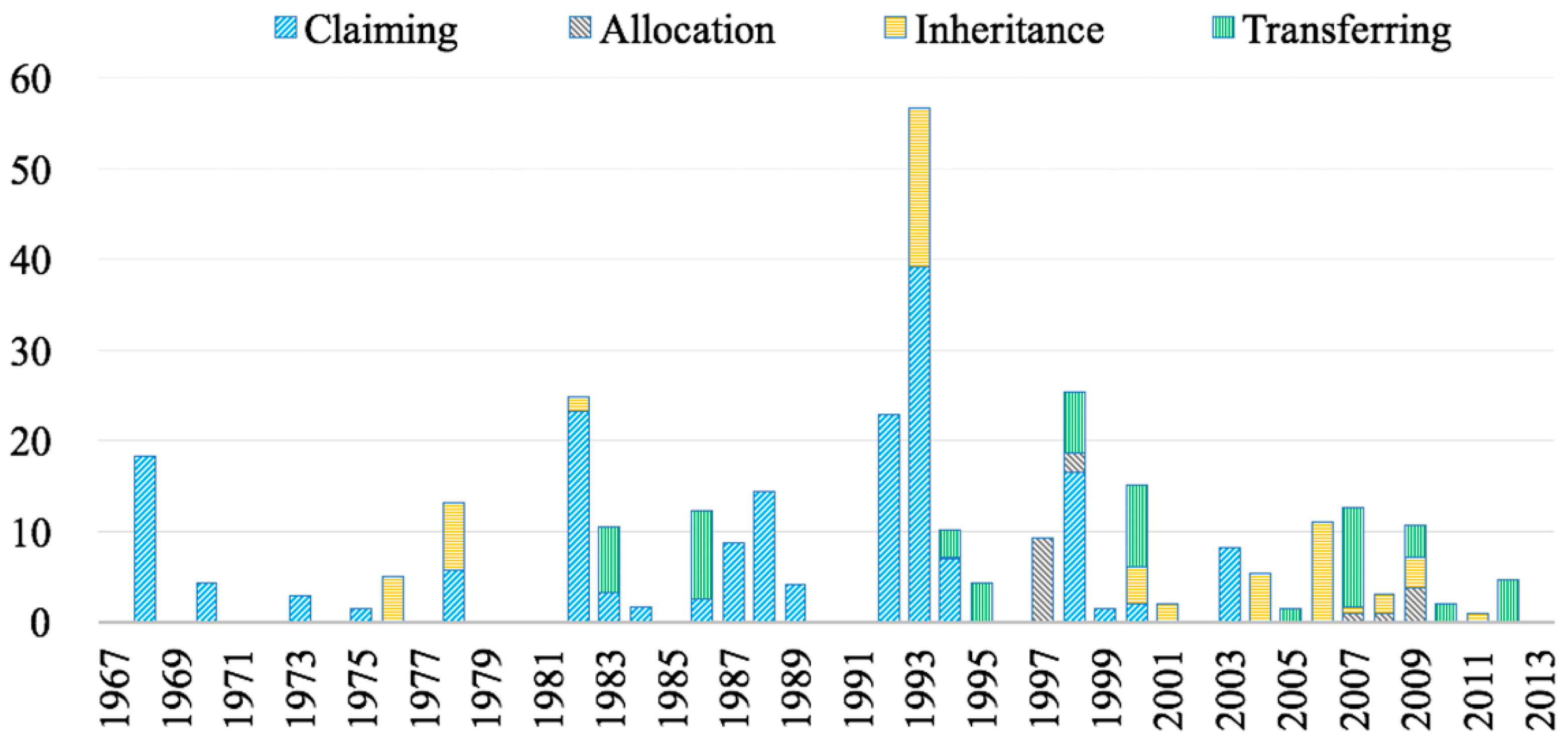Historical Changes of Land Tenure and Land Use Rights in a Local Community: A Case Study in Lao PDR
Abstract
:1. Introduction
2. Methods and Study Area
2.1. Methods
2.2. Study Area and Village
3. Results
3.1. How the Granting of Land Use Rights Has Changed in Laos
3.1.1. Granting Permanent Land Use Rights through the LTP
3.1.2. Granting Temporary Land Use Rights through the LFA
3.1.3. Land Transformation and the Politics of Policy
3.2. How Changes Occurred in the Case Study Village
3.2.1. The History of Household Settlement in the Study Village
3.2.2. Historical Changes of Household Land Tenure
(1) Customary Practice before 1993
(2) First Land Registration Program in 1993
(3) Land and Forest Allocation Program (LFA) in 1998
(4) Land Use Planning in 2007
(5) Pilot Land and Natural Resources Registration in 2009
3.2.3. How Households Obtained Land Use Rights
(1) Acquisition of Paddy Field and Upland Agricultural Areas
(2) Agricultural Area and Forestland within Groups of Households
(3) Changes of Landholders from Villagers to Outsiders
4. Discussion
4.1. Safeguarding and Shifting of Land Tenure and Land Use Rights
4.2. Land and Forest Formalization and the Changing of Land Tenure
4.3. Inequality in Obtaining Land Use Rights among Individual Households
5. Conclusions
Supplementary Materials
Acknowledgments
Author Contributions
Conflicts of Interest
References and Notes
- Yasmi, Y.; Kelley, L.; Enters, T. Conflict over Forests and Land in Asia: Impacts, Causes, and Management; RECOFTC: Bangkok, Thailand, 2010. [Google Scholar]
- Holstein, L. Towards Best Practice from World Bank Experience in Land Titling and Registration. 1996. Available online: https://www.rmportal.net/framelib/ltpr/052709/holstein-wb-best-practices-titling.pdf (accessed on 4 September 2015).
- Hall, D.; Hirsch, P. Land titling in Southeast Asia: Debates and conundrums. In Proceedings of the Conference on Revisiting Agrarian Transformations in Southeast Asia: Empirical, Theoretical and Applied Perspectives, Chiang Mai, Thailand, 13–15 May 2010.
- Hall, D.; Hirscb, P.; Li, T.M. Introduction to Powers of Exclusion: Land Dilemmas in Southeast Asia; National University of Singapore Press: Singapore, 2011. [Google Scholar]
- Corbera, E. Powers of exclusion. Land dilemmas in Southeast Asia. J. Peasant Stud. 2012, 39, 221–225. [Google Scholar] [CrossRef]
- Lastarria-Cornhiel, S. Who Benefits from Land Titling? Lessons from Bolivia and Laos; International Institute for Environment and Development (IIED): London, UK, 2007. [Google Scholar]
- Dixon, R.; Lunnay, C. Lao Land Titling Project: Implementation and Lessons; Unpublished work; 2009. [Google Scholar]
- Ducourtieux, O.; Castella, J. Land reforms and impact on land use in the uplands of Vietnam and Laos: Environmental protection or poverty alleviation? In Proceedings of the Colloque International “Les Frontières de la Question Foncière – At the Frontier of Land Issues”, Montpellier, France, 17–19 May 2006.
- Soulivanh, B.; Chanthalasy, A.; Suphida, P.; Lintzmeyer, F. Study on Land Allocation to Individual Households in Rural Areas of Lao PDR; German Technical Cooperation: Vientiane, Lao PDR, 2004. [Google Scholar]
- Fujita, Y.; Phengsopha, K.; Vongvisouk, T.; Thongmanivong, S. Post-socialist land reform in Lao PDR and its impact on community land and social equity. In Proceedings of the Eleventh Conference of the International Association for the Study of Common Property (IASCP), Bali, Indonesia, 19–23 June 2006.
- Vandergeest, P. Land to some tillers: Development-induced displacement in Laos. Int. Soc. Sci. J. 2003, 55, 47–56. [Google Scholar] [CrossRef]
- USIAD. Lao People’s Democratic Republic (Lao PDR)—Property Rights and Resource Governance Profile. 2013. Available online: http://www.usaidlandtenure.net/sites/default/files/country-profiles/full-reports/USAID_Land_Tenure_Laos_Profile.pdf (accessed on 16 January 2015).
- Mann, E.; Luangkhot, N. Study on Women’s Land and Property Rights Under Customary or Traditional Tenure Systems in Five Ethnic Groups of Lao PDR; Land Policy Study No. 13 under LLTP II; Lao-German Land Policy Development Project: Vientiane, Lao PDR, 2008. [Google Scholar]
- LIWG. Key Recommendations for the Lao National Land Policy; Land Issues Working Group (LIWG): Vientiane, Lao PDR, 2014. [Google Scholar]
- Dwyer, M.B. Trying to Follow the Money: Possibilities and Limits of Investor Transparency in Southeast Asia’s Rush for “Available” Land; CIFOR: Bogor, Indonesia, 2015. [Google Scholar]
- Dwyer, M.B.; Ingalls, M. REDD + at the Crossroads: Choices and Tradeoffs for 2015–2020 in Laos; CIFOR: Bogor, Indonesia, 2015. [Google Scholar]
- PROFEP. Management Plan for Forest Resources Development, Training and Research in the Management Intervention Area of Sangthong District, Vientiane Municipality 2001–2010; Promotion of Forestry Education Project (PROFEP), Faculty of Forestry, National University of Laos: Vientiane, Lao PDR, 2000. [Google Scholar]
- Kirk, M. Land Tenure Development and Divestiture in Lao P.D.R; Deutsche Gesellschaft für Technical Zusammenarbeit (GTZ): Vientiane, Lao PDR, 1996. [Google Scholar]
- Hirsch, P.; Scurrah, N. The political economy of land governance in the Mekong Region: Contexts of policy advocacy. In Proceedings of the International Academic Conference on Land Grabbing, Conflict and Agrarian-Environmental Transformations: Perspectives from East and Southeast Asia, Chiang Mai University, Chiang Mai, Thailand, 5–6 June 2015. Conference Paper No. 48.
- Baird, I.G. Turning land into capital, turning people into labor: Primitive accumulation and the arrival of large-scale economic land concessions in the Lao People’s Democratic Republic. New Propos. J. Marx. Interdiscip. Inq. 2011, 5, 10–26. [Google Scholar]
- Kenney-Lazar, M. Authoritarian resource governance and emerging peasant resistance in the context of Sino-Vietnamese Tree Plantations, Southeastern Laos. In Proceedings of the International Academic Conference on Land Grabbing, Conflict and Agrarian-Environmental Transformations: Perspectives from East and Southeast Asia, Chiang Mai University, Chiang Mai, Thailand, 5–6 June 2015. Conference Paper No. 2.
- Hett, C.; Nanhthavong, V.; Saphangthong, T.; Robles, G.R.; Phouangphet, K.; Epprecht, M.; Heimimann, A.; Messerli, P. Land deals in Laos: First insights from a new nationwide initiative to assess the quality of investments in land. In Proceedings of the International Academic Conference on Land Grabbing, Conflict and Agrarian-Environmental Transformations: Perspectives from East and Southeast Asia, Chiang Mai University, Chiang Mai, Thailand, 5–6 June 2015. Conference Paper No. 18.
- Virachit, V.; Lunnay, C. The lao land titling project—Innovative land tools in Lao PDR. In Proceedings of the Expert Group Meeting on Secure Land Tenure: “New Legal Frameworks and Tools” (UNESCAP), Bangkok, Thailand, 8–9 December 2005; pp. 1–13.
- Rusanen, L. In Whose Interests?: The Politics of Land Titling; Background Paper; AID/Watch: Sydney, Australia, 2005. [Google Scholar]
- Land Law; National Assembly: Vientiane, Lao PDR, 2003.
- Prime Minister’s Office. Decree on the Implementation of the Land Law; Prime Minister’s Office: Vientiane, Lao PDR, 2008.
- Burapha Development Consultants. Final Report of the Social Assessment for the Six Served Provinces and Two Unserved Provinces of the Lao PDR Land Titling Project; Burapha Development Consultants: Vientiane, Lao PDR, 2003. [Google Scholar]
- Government of Laos. Five Year National Socio-Economic Development Plan VIII (2016–2020); Government of Laos: Vientiane, Lao PDR, 2015.
- Vaenkeo, S. Land title issuance accelerated but target won’t be met. Vientiane Times, 15 June 2015. [Google Scholar]
- Vaenkeo, S. Govt set to issue 60,000 land titles next fiscal year. Vientiane Times, 17 September 2015. [Google Scholar]
- Vaenkeo, S. Ministry reaffirms plan to issue 400,000 land titles by 2020. Vientiane Times, 15 October 2015. [Google Scholar]
- Fujita, Y.; Phanvilay, K. Land and forest allocation in Lao People’s Democratic Republic: Comparison of case studies from community-based natural resource management research. Soc. Nat. Resour. 2008, 21, 120–133. [Google Scholar] [CrossRef]
- Manivong, K.; Sophathilath, P. Land Use Planning and Land Allocation in the Upland of Northern Laos: Process Evaluation and Impacts; The Economy and Environment Program for Southeast Asia (EEPSEA): Singapore, 2009. [Google Scholar]
- National Agriculture and Forestry Research Institute (NAFRI). Research Report on The Effect of Village Re-Location on Previous Land Allocation in Phonexay, Luang Prabang and Namo, Oudomxay; Lao Swedish Upland Agriculture and Forestry Research Program (LSUAFRP), NAFRI: Vientiane, Lao PDR, 2007. [Google Scholar]
- Moizo, B. Implementation of the land allocation policy in the Lao PDR: Origins, problems, adjustments and local alternatives. In Proceedings of the Workshop on Poverty Reduction and Shifting Cultivation Stabilisation in the Uplands of Lao PDR: Technologies, Approaches and Methods for Improving Upland Livelihoods, Luang Prabang, Lao PDR, 27–30 January 2004; pp. 103–116.
- Lestrelin, G.; Bourgoin, J.; Bouahom, B.; Castella, J.C. Measuring participation: Case studies on village land use planning in northern Lao PDR. Appl. Geogr. 2011, 31, 950–958. [Google Scholar] [CrossRef]
- Naughton-Treves, L.; Day, C. Lessons about Land Tenure, Forest Governance and REDD+ Case Studies from Africa, Asia and Latin America; UW-Madison Land Tenure Center: Madison, WI, USA, 2012. [Google Scholar]
- Phengkhay, C. Women and Land Allocation in Lao PDR. Master’s Thesis, Asian Institute of Technology, Bankok, Thailand, 1999. [Google Scholar]
- Ducourtieux, O.; Laffort, J.R.; Sacklokham, S. Land policy and farming practices in Laos. Dev. Change 2005, 36, 499–526. [Google Scholar] [CrossRef]
- Scurrah, N.; Hirsch, P. The Political Economy of Land Governance in Lao PDR; Sisattanak District: Vientiane, Lao PDR, 2015. [Google Scholar]
- Dwyer, M. Turning Land into Capital: A Review of Recent Research on Land Concessions for Investment in Lao PDR; Land Issues Working Group: Vientiane, Lao PDR, 2007. [Google Scholar]
- NA. Constitution of the Lao People’s Democratic Republic; National Assembly: Vientiane, Lao PDR, 2003. [Google Scholar]
- Chokkalingam, U.; Phanvilay, K. Forest Governance Assessment for REDD+ Implementation in Lao PDR through Application of the PROFOR Forest Governance Tool; Forest Carbon Partnership Facility (FCPF): Washington, DC, USA, 2014. [Google Scholar]
- Danielle, T. Trends in Southeast Asia. Chinese Engagement in Laos: Past, Present, and Uncertain Future; ISEAS: Singapore, 2015. [Google Scholar]
- Baird, I.G. Political memories of conflict, economic land concessions, and political landscapes in the Lao People’s Democratic Republic. Geoforum 2014, 52, 61–69. [Google Scholar] [CrossRef]
- Baird, I.G.; Le Billon, P. Landscapes of political memories: War legacies and land negotiations in Laos. Polit. Geogr. 2012, 31, 290–300. [Google Scholar] [CrossRef]
- Suhardiman, D.; Giordan, M.; Keovilignavong, O.; Sotoukee, T. Revealing the hidden effect of land grabbing through better understanding of farmers’ strategies in dealing with land loss. Land Use Policy 2015, 49, 195–202. [Google Scholar] [CrossRef]
- Guttal, S.; Manahan, M.A.; Militante, C.; Morrissey, M. Keeping Land Local: Reclaiming Governance from the Market Land; LRAN and Focus on the Global South: Bangkok, Thailand, 2014. [Google Scholar]
- Funke, I.E. Analysis of Land Allocation and Implications on Land Management: A Case Study of Two Villages in Sang Thong District, Vientiane Municipality, Lao PDR. Master’s Thesis, Dresden University of Technology, Tharandt, Germany, 2001. [Google Scholar]
- Kenney-Lazar, M. Plantation rubber, land grabbing and social-property transformation in southern Laos. J. Peasant Stud. 2012, 39, 1017–1037. [Google Scholar] [CrossRef]
- De Schutter, O. How not to think of land-grabbing: three critiques of large-scale investments in farmland. J. Peasant Stud. 2011, 38, 249–279. [Google Scholar] [CrossRef]
- Thongmanivong, S.; Fujita, Y. Recent land use and livelihood transitions in Northern Laos. Mt. Res. Dev. 2006, 26, 237–244. [Google Scholar] [CrossRef]
- Schlager, E.; Elinor, O. Property-rights regimes and natural resources: A conceptual analysis. Land Econ. 1992, 68, 249–262. [Google Scholar] [CrossRef]
- Meinzen-Dick, R.S.; Brown, L.R.; Feldstein, H.S.; Quisumbing, A.R. Gender, property rights, and natural resources. World Dev. 1997, 25, 1303–1315. [Google Scholar] [CrossRef]
- Sikor, T.; Auld, G.; Bebbington, A.J.; Benjaminsen, T.A.; Gentry, B.S.; Hunsberger, C.; Izac, A.M.; Margulis, M.E.; Plieninger, T.; Schroeder, H.; et al. Global land governance: From territory to flow? Curr. Opin. Environ. Sustain. 2013, 5, 522–527. [Google Scholar] [CrossRef]
- Barney, K. Power, Progress and Impoverishment: Plantations, Hydropower, Ecological Change and Community Transformation in Hinboun District, Lao PDR; York Centre for Asian Research (YCAR), York University: Toronto, ON, Canada, 2007. [Google Scholar]
- Baird, I.; Fox, J. How land concessions affect places elsewhere: Telecoupling, political ecology, and large-scale plantations in Southern Laos and Northeastern Cambodia. Land 2015, 4, 436–453. [Google Scholar] [CrossRef]
- Baird, I.G. Land, rubber and people: Rapid agrarian changes and responses in Southern Laos. J. Lao Stud. 2009, 1, 1–47. [Google Scholar]
- Friis, C. Small-scale land acquisitions, large-scale implications: The case of Chinese banana investments in Northern Laos. In Proceedings of the International Academic Conference on Land Grabbing, Conflict and Agrarian-Environmental Transformations: Perspectives from East and Southeast Asia, Chiang Mai University, Chiang Mai, Thailand, 5–6 June 2015. Conference Paper No. 36.








© 2016 by the authors; licensee MDPI, Basel, Switzerland. This article is an open access article distributed under the terms and conditions of the Creative Commons Attribution (CC-BY) license (http://creativecommons.org/licenses/by/4.0/).
Share and Cite
Boutthavong, S.; Hyakumura, K.; Ehara, M.; Fujiwara, T. Historical Changes of Land Tenure and Land Use Rights in a Local Community: A Case Study in Lao PDR. Land 2016, 5, 11. https://doi.org/10.3390/land5020011
Boutthavong S, Hyakumura K, Ehara M, Fujiwara T. Historical Changes of Land Tenure and Land Use Rights in a Local Community: A Case Study in Lao PDR. Land. 2016; 5(2):11. https://doi.org/10.3390/land5020011
Chicago/Turabian StyleBoutthavong, Saykham, Kimihiko Hyakumura, Makoto Ehara, and Takahiro Fujiwara. 2016. "Historical Changes of Land Tenure and Land Use Rights in a Local Community: A Case Study in Lao PDR" Land 5, no. 2: 11. https://doi.org/10.3390/land5020011






